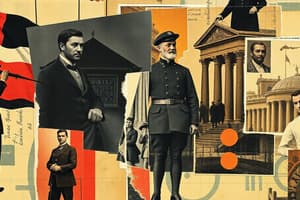Podcast
Questions and Answers
What was a significant factor contributing to the demographic collapse during the Great Dying in the Americas?
What was a significant factor contributing to the demographic collapse during the Great Dying in the Americas?
- Old-World diseases (correct)
- Urbanization
- Increased birth rates
- Widespread agricultural practices
Which of the following items was NOT part of the Columbian Exchange?
Which of the following items was NOT part of the Columbian Exchange?
- Wheat (correct)
- Sugar
- Corn
- Tobacco
Which social structure characterized colonial societies in the Americas, particularly in the Aztec and Inca regions?
Which social structure characterized colonial societies in the Americas, particularly in the Aztec and Inca regions?
- Meritocracy
- Casta system (correct)
- Classless society
- Feudal system
What was a primary economic driver in the Portuguese colonies of Brazil during the 1570s to 1670s?
What was a primary economic driver in the Portuguese colonies of Brazil during the 1570s to 1670s?
Which factor was most significant in the British colonies in North America during the colonial period?
Which factor was most significant in the British colonies in North America during the colonial period?
What was a notable consequence of Peter the Great's policies in Russia?
What was a notable consequence of Peter the Great's policies in Russia?
During which period did the Qing dynasty expand into the West and solidify its power?
During which period did the Qing dynasty expand into the West and solidify its power?
In the context of the Mughal Empire, who was known for his policy of religious tolerance and cultural integration?
In the context of the Mughal Empire, who was known for his policy of religious tolerance and cultural integration?
Flashcards
European Advantage
European Advantage
The European advantage was a combination of factors that allowed them to conquer the Americas. These factors included advanced technology, strategic alliances with indigenous groups, and superior sailing techniques.
Great Dying
Great Dying
The Great Dying refers to the devastating impact of European diseases on the indigenous populations of the Americas. Millions died from illnesses like smallpox and measles, to which they had no immunity.
Columbian Exchange
Columbian Exchange
The Columbian Exchange was a complex network of exchange between the Americas, Europe, Africa, and Asia. It encompassed the movement of people, plants, animals, diseases, and ideas.
These include the introduction of American crops like corn and potatoes to Europe, and the spread of European diseases to the Americas.
Encomienda, Repartimiento, and Hacienda
Encomienda, Repartimiento, and Hacienda
Signup and view all the flashcards
Creoles and Peninsulares
Creoles and Peninsulares
Signup and view all the flashcards
Mestizos and Castas
Mestizos and Castas
Signup and view all the flashcards
Yasak
Yasak
Signup and view all the flashcards
Peter the Great
Peter the Great
Signup and view all the flashcards
Study Notes
Power World History - Chapter 13
- Chapter 13 focuses on political transformations and encounters from 1450-1750.
European Empires in the Americas
-
European Advantage:
- Geography and favorable winds aided European exploration and conquest.
- European societies, driven by perceived marginality, land hunger, and social pressures, sought expansion.
- Advanced organization, technology (including weaponry and navigation), and local alliances supported European dominance.
- The introduction of Old World diseases decimated indigenous populations.
-
The Great Dying:
- An estimated 60-80 million people died as a result of diseases to which they lacked immunity.
- European introduced Old World diseases were devastating.
- The indigenous populations suffered a severe demographic collapse.
-
Columbian Exchange:
- The exchange of people, plants, animals, and germs between the Americas and the Old World.
- The exchange led to the transfer of crops like corn and potatoes to Europe, Africa, and Asia.
- The Americas contributed tobacco, chocolate, and other goods.
- Key exports from the Americas included silver, slaves, and sugarcane.
- Europe was the primary beneficiary of the trade.
-
Colonial Societies in the Americas:
-
Aztecs and Incas:
- Structures like encomienda, repartimiento, and haciendas characterized this region's social organization.
- Distinctions and social hierarchies like Creoles, peninsulares, mestizos, and castas emerged.
- Indigenous populations were a substantial component of the society.
-
Colonies of Sugar:
- Portuguese Brazil dominated the 1570-1670 sugarcane trade.
-
Settler Colonies in North America:
- British colonization of North America involved a society in transition, with class distinctions alongside gender inequalities.
- Racial mixing was limited compared to other empires.
- Protestantism and a less centralized royal control characterized these settlements.
-
The Steppes and Siberia: The Making of a Russian Empire
-
Experiencing the Russian Empire:
- Russia's expansion involved conquest and the gathering of tribute (yasak).
- Settlers put pressure on nomadic pastoralist communities.
-
Russians and Empire:
- Russia became a multiethnic empire.
- The Russian Empire accumulated significant wealth.
- Peter the Great, ruling from 1689 to 1725, engaged with Western Europe.
- Extensive contact with China and Islamic realms fostered cultural exchange.
Asian Empires
-
Making China an Empire:
- The Qing dynasty expanded westward (1680-1760).
- It's debatable whether or not the process qualifies as colonialism.
- Economic issues arose in central Asia.
-
Muslims and Hindus in the Mughal Empire:
- The Mughal Empire had a population of roughly 20% Muslims.
- Significant figures like Akbar (r. 1556-1605) and Ahmad Sirhindi (1564-1624) shaped its trajectory.
- Aurangzeb (1658-1707) also left an impact.
-
Muslims and Christians in the Ottoman Empire:
- The Ottoman Empire wielded its influence through the expression "The Sword of Islam".
- Women’s autonomy was constrained albeit with specific rights. The importance of Turkic groups increased in the Islamic world.
- Balkan, Armenian, and Orthodox Christians were part of the wider Ottoman Empire.
- The empire was observed with a combination of fear and respect in the west.
Studying That Suits You
Use AI to generate personalized quizzes and flashcards to suit your learning preferences.




